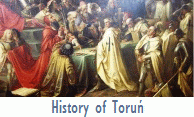|
In the Old Market in Torun there is a monument commemorating the man who is probably known all over the world. The Latin inscription on the pedestal says: Nicholas Copernicus, born in Torun, moved the Earth, stopped the Sun and the sky. His discovery excluded the central position of our planet in the Universe and refuted the earlier theories of Ancient Greeks. It enabled us to understand that the Earth is just one of many planets and that the Cosmos is enormous. Contemporary researches allow us to learn much more about the structure of the Universe. Now, we understand that the Earth, despite its enormity, is just a speck suspended in incredibly vast space that is filled with huge constructions, and that it is only a tiny link between these constructions. The Earth is just a particle that has its time and space in the outer space. The Earth is the third planet and, like the other planets of our system, it rotates around the centrally situated Sun. The Moon, our closest neighbour, is just1 light second away from the Earth. Next, there is the Mars, asteroids and the Jupiter, the most beautiful planet. Further, there is the Uranus, Neptune and Pluto. The borders of the Solar System are marked out by the ice cocoon which consists of billions of frozen pieces. Beyond the border of the Solar System, there is space filled with myriad of stars - other suns suspended in the boundlessness of the Cosmos. The nearest neighbour is situated more than 4 light years away. It is Alfa Centauri - the system of three stars connected with each other with strong gravitation forces. Going further, we come across Sirius, the stars that make Orion constellation. Next, we dive into a huge cloud of gas and dust - the birthplace of many other stars. If we have a look from even a further distance, we can see that all celestial objects form a huge, flat spiral. This is our galaxy - the Milky Way. Each shining spot of light is a star, a cloud or a cluster of stars. And there are more than 100 billion of spots like that. Our Sun with its planets also make one of many golden spots. Not long ago, the Milky Way was thought to be the whole Universe. Today we know that there are many more galaxies like ours. Galaxies are not scattered regularly. They make up galaxy clusters which then form the biggest structures in the Cosmos. Their long threads resemble gigantic net whose each string is made of billions of galaxies. And each galaxy is a collection of billions of stars. Nine planets rotate around one of them, the Sun. The third planet is our microscopic and, at the same time, enormous home. Nowadays, thanks to modern observational technology, we can describe not only the construction of the Cosmos but also its history. The researches show that the Universe began its life with the most powerful explosion about 15 billion years ago. At first, the spreading fireball was filled with radiation and elementary particles which later formed the simplest elements, hydrogen and helium. The initial, regular distribution was disturbed and resulted in heterogeneity, which was like wrinkles on the surface of the young Universe. They gave rise to the first objects called quasars. Probably they received powerful energy from black holes hidden in their centers. As time went by, the surrounding gas shaped flat spirals and stars started their existence in their branches. This is the way galaxies came into being. In one corner of our galaxy, called the Milky Way, a cloud of gas and dust drifted. The cloud's center became denser and that triggered the rise of temperature. As a result our Sun started shining. The cloud formed a ring where planets came to being. The third planet was the newborn Earth. The process took place less than 5 billion years ago. At present, the Sun together with its planetary family is at the peak of its maturity. However, such a state won't last forever. In next 5 billion years, the supply of hydrogen fuel in the Sun core will start running low. Our star will become a red giant and will devour the Earth and the neighbouring planets in its burning atmosphere. Finally it will reject the outer layer and turn into a spectacular nebula. After many billions of years the ubiquitous hydrogen, thanks to which the stars shine, will start running low. More and more often black holes - the remnants of burnt, massive objects, will appear on the cosmic stage. The stars that will still exist will be also devoured by collapsars. Finally there will be darkness, coldness and deadness everywhere. Unfortunately, the vision of the Universe future is not optimistic. Today, when the Cosmos is still young we may enjoy its beauty. We are given an incredibly long time to live, learn and take advantage of opportunities. The darkness of the Cosmos does not have to be our apocalypse. Maybe in thousands or millions of years it won't be a problem to supply the dying Sun with fuel? Maybe one day our microscopic link in the Universe will become its foundation? Who knows ... Let's not waste opportunities.
|
| All rights reserved Toruń 2005-2009 | About us | CenterMedia |




















